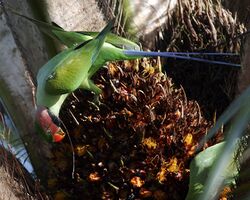Biology:Long-tailed parakeet
| Long-tailed parakeet | |
|---|---|

| |
| Pair feeding in Queenstown, Singapore (the male is in the foreground) | |
| Scientific classification Error creating thumbnail: Unable to save thumbnail to destination
| |
| Domain: | Eukaryota |
| Kingdom: | Animalia |
| Phylum: | Chordata |
| Class: | Aves |
| Order: | Psittaciformes |
| Family: | Psittaculidae |
| Genus: | Psittacula |
| Species: | P. longicauda
|
| Binomial name | |
| Psittacula longicauda (Boddaert, 1783)
| |
The long-tailed parakeet (Psittacula longicauda) or Burung Bayan Nuri in Malay is a parakeet endemic to the regions of Andaman and Nicobar islands, Sumatra, Borneo and Peninsular Malaysia (including Singapore). It is allopatric with the congener, the Red-breasted parakeet, Psittacula alexandri, except in the Andaman islands where they occur together.
Taxonomy
The long-tailed parakeet was described by the French polymath Georges-Louis Leclerc, Comte de Buffon in 1780 in his Histoire Naturelle des Oiseaux.[1] The bird was also illustrated in a hand-coloured plate engraved by François-Nicolas Martinet in the Planches Enluminées D'Histoire Naturelle which was produced under the supervision of Edme-Louis Daubenton to accompany Buffon's text.[2] Neither the plate caption nor Buffon's description included a scientific name but in 1783 the Dutch naturalist Pieter Boddaert coined the binomial name Psittacus longicauda in his catalogue of the Planches Enluminées.[3] The type locality is Malacca on the southern region of the Malay Peninsula.[4] The long-tailed parakeet is now placed in the genus Psittacula that was introduced by the French naturalist Georges Cuvier in 1800.[5][6] The name of the genus is a diminutive of the Latin word psittacus for a "parrot". The specific epithet longicauda combines the Latin longus meaning "long" and cauda meaning "tail".[7]
Five subspecies are currently recognized:[6][8]
- P. l. tytleri (Hume, 1874) – Andaman long-tailed parakeet – Andaman and Coco Islands
- P. l. nicobarica (Gould, 1857) – Nicobar long-tailed parakeet – Nicobar Islands
- P. l. modesta (Fraser, 1845) – Enggano long-tailed parakeet – Enggano Island
- P. l. longicauda (Boddaert, 1783) – common long-tailed parakeet – south Malay Peninsula, Singapore, Sumatra, Nias, Bangka Island Anambas Islands, Borneo
- P. l. defontainei Chasen, 1935 – Natuna Islands
Description
It is mainly green with a long blue tail. The male has a black cap and red face. The female lacks the black cap and has less red.
Habitat
The long-tailed parakeet is able to live in a wide variety of habitats such as in swamp forests, lowland evergreen forest, oil palm plantations, coconut plantations, gardens, public parks, and is a frequent visitor to agricultural areas (especially those who yield tropical fruits and seeds). It is usually seen in elevations of up to 300 meters.[9]
Ecology & Behavior
The long-tailed parakeet is an extremely social bird, always seen communicating with other birds of its species. Even though small groups are usually seen, flocks of thousands of birds have been in the Andaman Islands and Borneo. However, the large flocks tend to appear during breeding season. It is a colony breeder. Birds on the Malay Peninsula tend to breed from December to February while birds on the Nicobar and Andaman Islands tend to breed from February to March. Females tend to lay a clutch of 2 to 4 eggs approximately 30.5 x 24.5mm. It usually takes about 23 to 24 days for the eggs to hatch. Chicks fledge at around 7 weeks old. Its diet consists of a variety of berries, papaya, areca nuts, a wide variety of cultivated and wild fruit, seeds, and cultivated grains such as corn. It is a curious species, as it is often seen playing with sticks or other materials found in its environment.[9]
Threats
Much of the long-tailed parakeet's natural habitat is threatened by deforestation and illegal logging. Capture for the illegal pet trade is also a threat to the survival of this species.[9]
Gallery
References
- ↑ Buffon, Georges-Louis Leclerc de (1780). "La grande perruche à longs brins" (in fr). Histoire Naturelle des Oiseaux. 11. Paris: De L'Imprimerie Royale. pp. 217–218. https://biodiversitylibrary.org/page/42410142.
- ↑ Buffon, Georges-Louis Leclerc de; Martinet, François-Nicolas; Daubenton, Edme-Louis; Daubenton, Louis-Jean-Marie (1765–1783). "Perruche, de Malac". Planches Enluminées D'Histoire Naturelle. 9. Paris: De L'Imprimerie Royale. Plate 887. https://biodiversitylibrary.org/page/35224677.
- ↑ Boddaert, Pieter (1783) (in fr). Table des planches enluminéez d'histoire naturelle de M. D'Aubenton : avec les denominations de M.M. de Buffon, Brisson, Edwards, Linnaeus et Latham, precedé d'une notice des principaux ouvrages zoologiques enluminés. Utrecht. p. 53, Number 887. https://biodiversitylibrary.org/page/27822673.
- ↑ Peters, James Lee, ed (1937). Check-list of Birds of the World. 3. Cambridge, Massachusetts: Harvard University Press. p. 245. https://biodiversitylibrary.org/page/14477960.
- ↑ Cuvier, Georges (1800) (in fr). Leçons d'Anatomie Comparée. 1. Paris: Baudouin. Table near end. https://biodiversitylibrary.org/page/33516226.
- ↑ 6.0 6.1 Gill, Frank; Donsker, David, eds (2019). "Parrots, cockatoos". World Bird List Version 9.2. International Ornithologists' Union. https://www.worldbirdnames.org/bow/parrots/.
- ↑ Jobling, James A (2010). The Helm Dictionary of Scientific Bird Names. London: Christopher Helm. pp. 229, 321. ISBN 978-1-4081-2501-4. https://archive.org/details/helmdictionarysc00jobl.
- ↑ Collar, N.; Sharpe, C.J.; Boesman, P. (2019). "Long-tailed Parakeet (Psittacula longicauda)". in del Hoyo, J.; Elliott, A.; Sargatal, J. et al.. Handbook of the Birds of the World Alive. Lynx Edicions. https://www.hbw.com/node/54577.
- ↑ 9.0 9.1 9.2 "Long-tailed Parakeet (Psittacula longicauda)" (in en). World Parrot Trust. https://www.parrots.org/encyclopedia/long-tailed-parakeet.
External links
- Oriental Bird Images: Long-tailed Parakeet Selected photos
Wikidata ☰ Q1055832 entry
 |




